9 concepts that help to understand the Japanese culture
• 9 concepts that help to understand the Japanese culture
The charm of things, sad lonely, muffled on the verge of extinction of colors and sounds, the traces of time, eternal in the current, broken branches and other interesting metaphor, which hardly can be explained untranslatable Japanese words.
Advance notice. Exact definitions of the concepts discussed below are not there, they, like other ideas that emerged in Japan in the Middle Ages, vague, poorly formulated, but clearly felt. Translate them word impossible. European consciousness requires a clear logic, clear language, and Japanese soon puts the concepts into the shadows, refers to him more secretly, intimate. Hence many interpretations, on the one hand, on the other hand - the lack of any kind was explanatory, except metaphorically, mysterious.
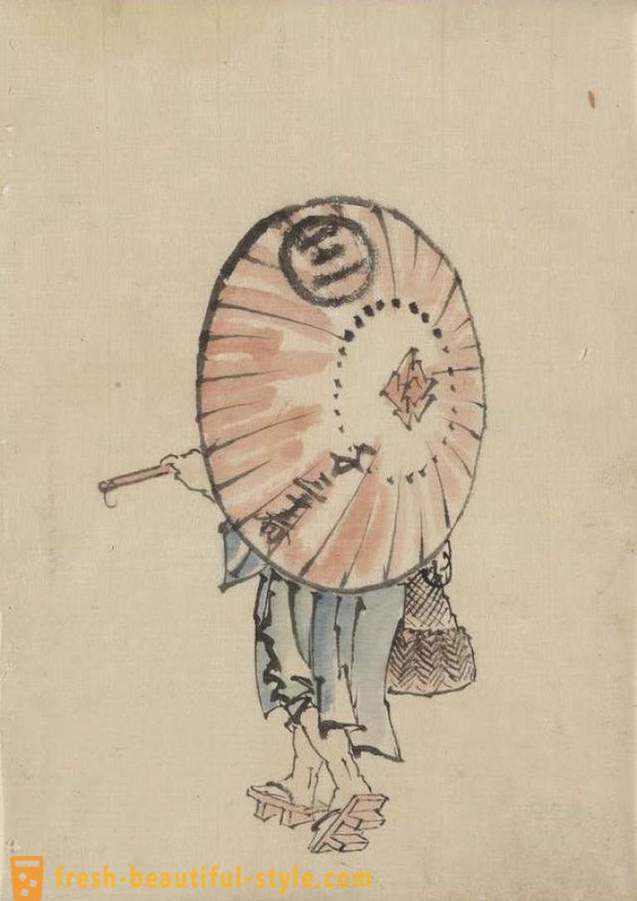
Katsushika Hokusai. 1830-1850 years
物 の 哀 れ
Mono no aware - literally "the charm of things." The concept, the whole story is permeated with classical literature, has developed the tenth century. Well simultaneous recovering from medieval texts: prose, poetry and essays. The concept of "things" needed in this case is interpreted broadly: the things - it's not just the objects of this world, but also the feelings of the people, and the people themselves. Avare - "sad charm" that occurs when looking at "the things of the world", the main feature of which - the fragility and volatility. Sad charm of things is largely connected with the realization impermanence, transience of life, with its unreliable, temporary nature. If life were not so fleeting, there would be no charm in it - it is written in the eleventh century, the famous writer. Mono no aware is connected also with extraordinary sensitivity, which is cultivated in the classical era Heian period (IX-XII century), the ability to capture the most subtle currents of life. One poet wrote that he heard the rustling of the blood coursing through her veins, hears the falling cherry petals. Avare meant exclamation transmitted interjection "ah!", And then acquired the meaning "charm." Other authors believe avare ritual exclamation: "avare" - so cried out to the most important moments of action and ideas of the ancient Shinto religion.
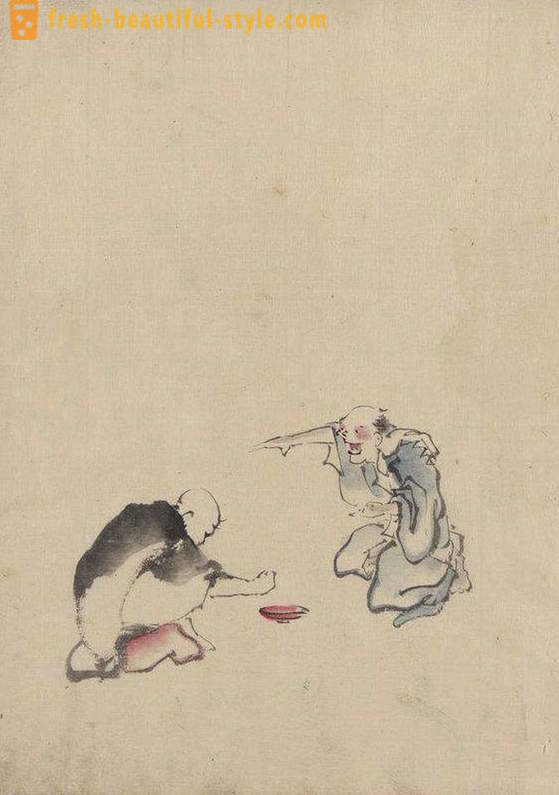
Katsushika Hokusai. Players. 1830-1850 years
無常
Mudzo - "ephemeral", "frailty", "variability". The notion has developed in the early Middle Ages under the influence of Buddhism, a special state of mind when a person is acutely aware of the transience of time, the fragility and volatility of each moment of life. Moment is experienced as something fleeting hands. Time kills people, feelings, destroying palaces and huts, changes the contours of the sea shore - this idea is not new, the new - in relation to the Japanese to the passage of time as something tragic is going through. Ephemerality, transience has become one of the major categories of Japanese culture for many centuries, this category is changing - in the seventeenth century, it takes the form of ukiyo "floating world", engraving artists who portrayed the world, his works called pictures of the floating world. In the eighteenth and nineteenth centuries, there are literary genres - "tales of drifting world." Frailty at this time is no longer perceived as tragic, ridiculed over it, one major writer of the time said: "Yes, we all swam, but fun, like pumpkin, bouncing on the waves."
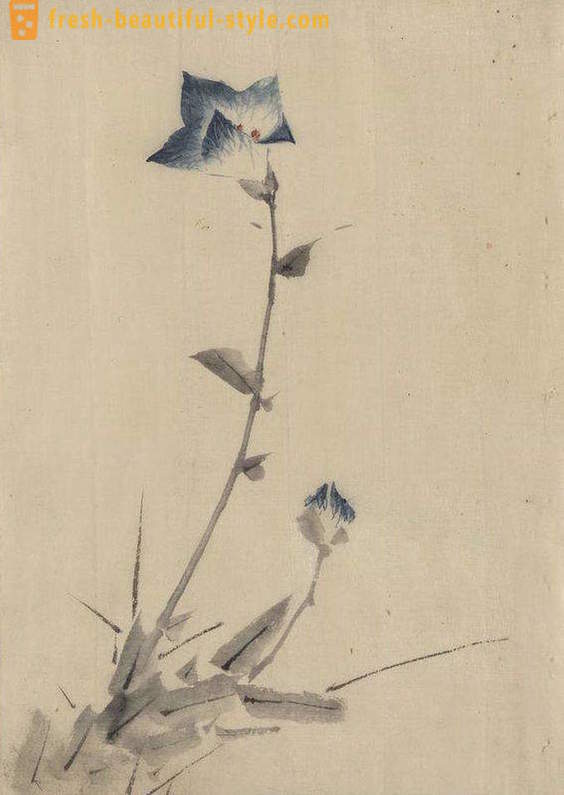
Katsushika Hokusai. Flower and bud. 1830-1850 years
寂 び 侘 び
Saby / wabi. Sabi - the concept of medieval aesthetics, can be described as "loneliness sadness", "poverty", "insipidity", "weak", "serenity", "shadow", "muffled to the point of disappearance of colors and sounds," "detachment." All these definitions describe a circle about values, but did not disclose it completely. The word is found in VIII century in the first poetry anthology of Japanese "Collection of myriad leaves" ( "Man'yoshu"). Poet Fujiwara no Shunzei in the twelfth century have used that word. In one of his pyatistishiya-tank is the image of "frozen stunted cane on the beach", which is considered as an early incarnation of sabi. However sabi aesthetic in its current form was created in the seventeenth century haiku poet Matsuo Basho and his followers. So I want to write, they formulated the principles of aesthetics, but it is not - rather, they knew how to blow a feeling of loneliness, sadness, detachment from worldly things in the spirit of the philosophy of Zen Buddhism. Influenced philosophy and seclusion, away from the world, solitary ascetic life in the mountains, poor, but inwardly focused - but this distinct philosophy does not explain everything. Nothing specific is said or written it was not - and this is the mystery of poetics sabi / wabi. When the poet Matsuo Basho asked what sabi, he replied that he is an old man himself, donning ceremonial dress to go to the palace. Basho never gave clear definitions, he expressed himself metaphorically, dropping mysterious phrases, full of hidden meanings, which are then interpreted his disciples. Sabi is difficult to grasp, it is impossible to poke a finger, it soon spilled into the air. Sabi is sometimes described as "ancient beauty". Wabi - sabi is the other side; to describe it, you can choose the word 'simplification'. If the string definition, then fit the word "poverty", "modesty", "poverty" (including the poverty of words for an image of something), "insipidity", "lonely wanderer in the path," "silence, which can be heard rare sounds - drops falling into a vat of water. " The absence of pathos, deliberate primitivism - is also wabi. Part of the definition coincides with the definition of wabi sabi, - on the other hand, are two different things, these concepts dvoyatsya. The tea ceremony, for example, sabi partly embodied in the concept of ANRE - "patina", "traces of time."
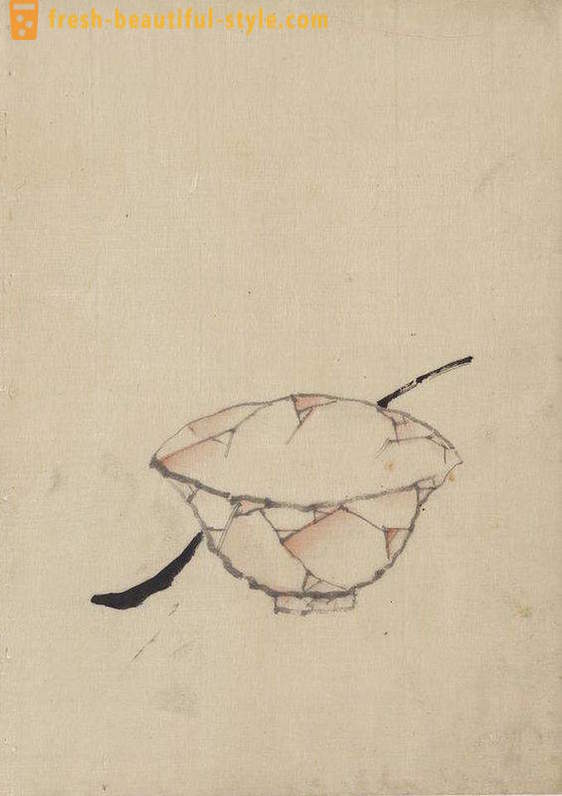
Katsushika Hokusai. A cup. 1830-1850 years

Project Declaration on the advertised website
慣 れ
Nare - "patina", "traces of time." As part of the aesthetics of ANRE is valued, such as jade stone in the bottom of which comprises a light haze, a thick dull shine, "as though deep in his stiffened piece of ancient air", as one famous writer wrote. In this coordinate system, crystal transparency is not appreciated: clarity, brilliance do not have to reverie. Japanese paper, which is made manually in the villages, also does not shine, it is friable surface gently absorbs the rays of light, "like a fluffy surface of loose snow." Patina of antiquity, a patina, the darkness thickens time embodied in the dark - black and dark red - Lacquer ware. He appreciated that "has a deep shadow, and not the superficial clarity." Nare - slight greasiness things: dishes, furniture, clothing - is because it is often touched by hands, and from them remains weak coating of fat, which is absorbed, creates a special warmth, a haze. Dull luster ware, muddy dark color Japanese marmalade yōkan sung wonderful writer Soseki Natsume in his memories of childhood, "The head of the grass" in dim indoor Japanese restaurants evoke exactly the feeling layers of darkness, and which achieves a clever artist.
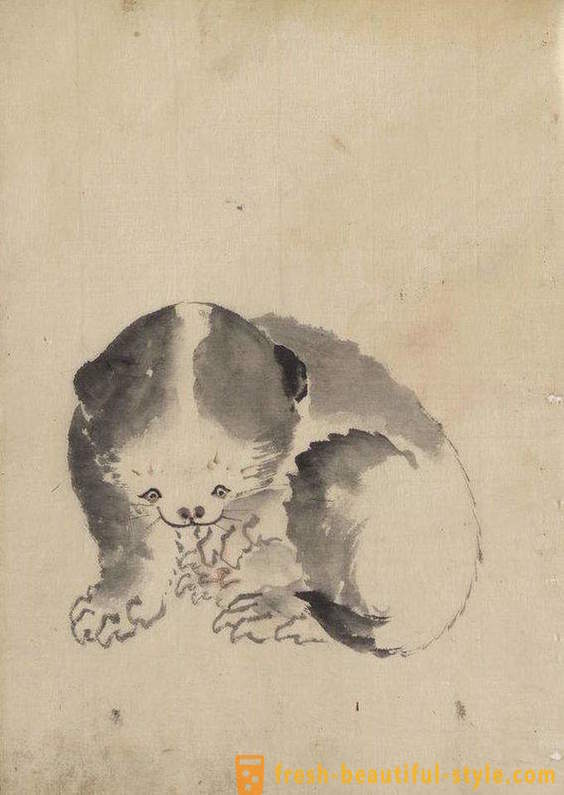
Katsushika Hokusai. Bamboo. 1830-1850 years
幽 玄
Yugen - "hidden beauty", "mysterious beauty". The most mysterious concept of Japanese aesthetics, it is difficult to be deciphered. It is known that this word came from the Chinese philosophical writings, which means "deep", "vague", "mysterious". Yugen is often understood as a non-rational comprehension of the sad beauty of the world and of human feelings. In poetry pyatistishiya-tank with the word "yugen" describes the deeper meaning of the poem, which should guess when reading text provides almost no clues. Thirteenth century poet Fujiwara no Taiko in his teaching offers Buddhist satori category - "inspiration" for understanding the hidden beauty, insight achieved the highest concentration of spirit, a sudden intuitive understanding the essence of things. Yugen - this is something that is hidden under the words, the fact that, for example, theater actor but can extract the text of the play. Zeami, founder of the theater but have inherited the word of poets, he wrote that "yugen - a subtle shade of bamboo on the bamboo." Zeami in his famous treatise "Notes on style flower" (XV century), complex pieces of theater, where reveal the secrets of the actor's art, he wrote, for example, that "the snow in a silver cup" - a flower of peace, quiet, tranquility, actor game can open this flower, which is not normally visible. Hidden, difficult to achieve beauty is within aesthetics yugen more than the beauty of a clear, open, bold.
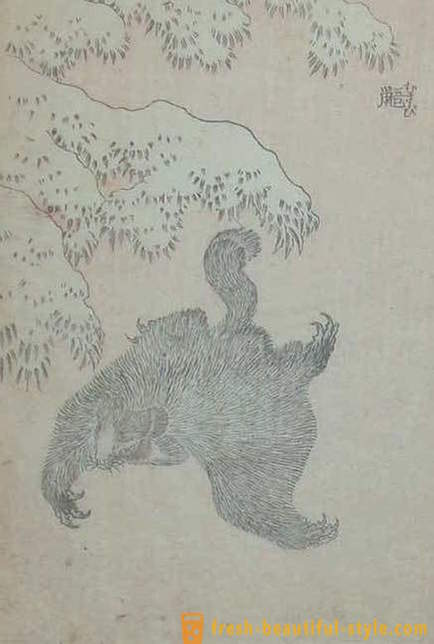
Katsushika Hokusai. Cat claws cleaning. About 1850
不易 流行
Fueki-Ryuko - "eternal - current" or "perpetual current". In poetry, haiku triplets fueki-Ryuko - this feeling of permanence and immutability of the eternal in a continuously changing world, it is the inviolability of poetic tradition, inseparably bound up with the variability of forms, it is a deep awareness that the eternal is merged with the current. Universal, "space" plan relates the poem with the natural world, a gyre of the seasons in the broadest sense. There is another plan in the poem - a concrete, substantive, tangible world is clearly outlined, rather, these things. Poet Takahama Kyoshi in the twentieth century, wrote: "In poetry there is no place more than the words of objects and phenomena, they attract people's hearts just a sound." Differences between "eternal" and "fluid" sometimes not immediately identified. Both elements should not automatically flow from one another, or between them will not voltage. At the same time, "they should not be completely independent; echoing one another, they must generate the same overtones and associations. " The unity of these two principles is the meaning of the poem.

Hokusai. Flying squirrel. About 1850
栞
Shiori - once word means "broken branch", that is a sign indicating the way to the forest, then "bookmark in the book," there is the literal meaning of "flexibility". Ciori - the state of spiritual concentration, necessary for understanding the deeper meaning of phenomena. Pupil Basho poet Coeur wrote that Shiori should be understood as "compassion", "sadness", "sorry", however, it is not expressed or the content of the poem, words or techniques, feeling Shiori can not be transferred in the usual manner, and concluded implied in (odzo), which is revealed through the association. "It's something that's hard to say the words and write with a brush" - words Coeur.
Katsushika Hokusai. Cucumber and eggplant. 1830-1850 years
渋 み
Sibumi - type and a sense of beauty, which arose in the fourteenth century, is associated with viscous tart taste of persimmon. When people talk about sibumi, remember well the bitter taste of green tea. Sibumi difficult to comprehend, this feeling just comes to a man without much explanation. Sibumi conveys a sense of the tart bitterness of life, simplicity, courage, renunciation of prettiness, the rawness of the form, the original imperfection. For example, prized cups for tea ceremony, in which there is a primordial nature of clay, from which it is made, they may be similar to the sink, on the pieces of wood, like found on the beach. Man, tea cup, sword, clothing, a poem, a picture can be Shibuya. The text can be in Shibuya innuendo, no extra, "beautiful" words. Shibuya is embodied through simplicity, closeness to nature, the absence of "-designed". Sibumi - is the highest measure of beauty and the beauty of praise. Some authors define sibumi as "effortless perfection" as the calm, "ease of mind". Sibumi not need to comprehend, it is itself. Sibumi - is not understanding, but mere knowledge without effort, is "eloquent silence". One writer believed that a free bird flying in the air can be sibumi. Illustration Source: Library of Congress.
Author Helen Dyakonov













































